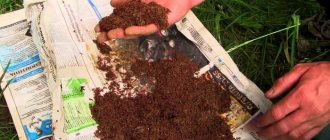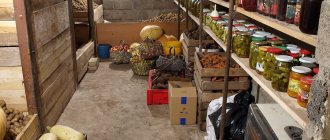You can store tulip bulbs in the cellar, basement, apartment and loggia. If you follow the recommendations of experienced gardeners, the plant will tolerate the procedure favorably, and after the next planting it will delight the owner with beautiful and noble flowering. It is recommended to dig up rhizomes after the end of the growing season so that they do not become buried in the soil, as this process can lead to rotting and death of the crop.
If you leave tulips in the ground after flowering, it will be difficult for them to “hatch” later.
When to dig up tulip bulbs
It is difficult to name the exact date when you should start digging up tulips after flowering. Summer residents usually do this in the first summer months. Also, the timing is determined depending on the growing region. In the southern part of the country, the procedure is carried out in June; for the middle zone, it is preferable to dig up tulips in July. You should focus on the color of the plants and their condition. A signal that the bulbs have formed and the time has come to remove them from the ground is yellow and wilted leaves. You can also judge that the plant is ripe by the condition of the rhizomes, the upper scales of which should acquire a brown color.
It is recommended to dig up the plant carefully, using a pitchfork. Along with the main bulb, all its children should be removed from the garden bed. It is advisable to carry out the procedure in cool and dry weather. If tulips of different ripening periods grow in the same flowerbed, then they should not be removed at the same time. This will make it easier to calibrate planting material by variety.
Attention! If you dig with a shovel, you can damage the plants.
If you dig up flowers ahead of schedule, they will not have time to accumulate the necessary nutrients.
How to properly prepare bulbs for storage
You can dig up flowers after the first two leaves have completely turned yellow and the tip of the stem is wrapped around your finger. Most often this is the beginning of summer. The gardener himself looks at what specific period it will be, focusing on the leaves: if they have turned yellow, then the bulb is formed and can be dug up. Brown scales on a tulip bulb indicate its maturity.
It is worth remembering that the ripening of the bulb occurs within a month. The foliage and stem dry out and turn yellow, and then fall off. Immediately after the tulip has bloomed, it must be removed so that the bulb can form better. If you dig it up too early, the root crop will not have time to ripen, and, accordingly, it will be painful to endure the winter. Yes, and problems with flowering and the formation of children next year are guaranteed.
Sorting should be done by size, grade, for better storage it is worth using separate containers. Disassemble the baby bulbs into slices; it is better to throw away any sick or damaged ones.
And clean off the remaining soil and disinfect it for 30 minutes in a weak solution of potassium permanganate. Water with potassium permanganate must cover the roots for complete disinfection. This will get rid of unwanted diseases and save you from pests.
The second option is disinfection in a solution of karbofos. And some gardeners soak the bulbs in hot water. The temperature must be at least 50°. After processing, dry the root vegetables by spreading them in a cool, ventilated area.
If drying is done outdoors, the bulbs should not be exposed to direct sunlight to avoid burns.
You can sort by several criteria:
- Onions of at least 4 cm are considered the best; they are classified as extra;
- from root crops 3-4 cm in size, you can expect full-fledged shoots and abundant flowering;
- 2 - 3 cm, of course they will bloom, but there will be either too few children or no children at all;
- It is better to dispose of small bulbs; they have too little vitality for growth and flowering.
Conditions for choosing storage
- The place where tulip bulbs are stored should have moderate humidity;
- The option of too warm rooms should also be discarded. They may simply dry out before autumn or spring (depending on the time of sowing) and will be unsuitable for planting;
- The normal temperature before autumn planting is considered to be 17 - 25 ° C, and for winter storage 23 - 25 ° C is suitable. If the temperature regime is disturbed, the bulbs will either freeze or only leaves will sprout, there will be no flowers;
Popular: What to do if the leaves of the calathea begin to turn yellow
Root crops should be stored in one place until planting. You should not cover tulips; the bulbs emit ethylene, which has a detrimental effect on children.
Is it possible to save tulip bulbs until spring?
If for some reason it is not possible to plant a plant in the fall, then you can preserve tulip bulbs at home until spring; there are several ways. It is convenient to store the material in pressed paper cassettes for eggs, peat boxes, in the refrigerator or on the balcony. Also, we should not forget that the main condition for storage in winter is stratification.
Important! If you neglect stratification, the plant will not bloom after planting.
Tulips planted in the spring bloom later than those planted in the fall
Is it possible to store tulip bulbs at home in winter?
It is very difficult to preserve tulips at home until spring, so it is better to try to plant them in a flowerbed in the fall. If this is not possible, then you can try to store the material in an unheated storage room or on a glazed balcony, provided that the temperature is maintained within +5-6 degrees. In addition, the room should be dark and dry. Every month, rhizomes should be inspected for mold and suspicious spots.
Warning! It is not recommended to store the bulbs in places unprotected from drafts, or near heating appliances.
In spring, tulips are first planted in boxes and then in the garden bed.
Can tulip bulbs be stored in the refrigerator?
If you need to save a small amount of planting material, it can be stored in the refrigerator. A shelf reserved for vegetables is good for this. In this case, the bulbs are wrapped individually in paper and care is taken to ensure that the temperature does not fall below 0 C.
Advice! In the refrigerator, tulips should be kept as far as possible from apples and pears, which emit ethylene, which is harmful to flowers.
Preparing plants for digging after flowering
You can determine when to dig up tulips by looking at the plants: if the leaves begin to turn yellow and become brittle, and the stem is elastic and bends without breaking, this indicates the flowers are ready.
What are the consequences of violating the excavation deadlines?
Digging up tulips prematurely can affect the development of the plant and the division of the bulb for propagation. If the timing is delayed, the bulbs may freeze or rot in rainy weather. Their planting site is often lost, and the rhizome remains in the ground and becomes a breeding ground for infections.
Many gardeners are interested in how to properly dig up tulips after flowering, whether they need preliminary preparation, and whether they should be trimmed. If, according to external signs, the plant is ready, the stem should be trimmed, leaving it two leaves high, this will allow the bulb to ripen faster.
After pruning, the plants are watered with soft, settled water at room temperature. Tulips love moisture, but do not allow the soil to become waterlogged. For convenience, you should dig a groove no more than 7 cm deep between the rows; approximately 400-500 ml of water will be needed per plant. After watering, fill the grooves with soil to prevent moisture from evaporating.
Don’t forget to feed the plants immediately after flowering to increase disease resistance. To do this, one of the mineral complex fertilizers is diluted in water: Kemira, Azofoska, Universal-2. It already contains nitrogen, potassium and phosphorus in the correct proportions.
Where to store tulip bulbs at home, in an apartment in winter
If there is a need to preserve tulip rhizomes until spring, you can use the wet germination method. To do this, the bulbs are placed in plastic boxes with peat or wet sawdust, sprinkled with substrate and put into the cellar. Moreover, even if the plant germinates, after planting it will bloom at the usual time.
In an apartment, you can try to preserve rhizomes using early forcing. To do this, they should be planted in boxes with soil and placed on the balcony. With the onset of frost, the plantings need to be covered with film, ventilated every two weeks, and watered as the soil dries out. After the sprouts hatch, it is recommended to place the boxes in a lighted place.
Preserving dug tulips in winter is much more difficult than in summer.
How to properly store tulip bulbs after digging until spring
Prepared, unplanted tulip bulbs can be preserved until spring only by correctly following all the recommendations. Dried and peeled rhizomes should be placed in a warm, dry and ventilated room: barn, cellar, basement. In an apartment, a balcony is suitable for this purpose, but the bulbs should be protected from direct sunlight. In a country house, containers with rhizomes can be kept in the attic.
Important! When storing material, access to it by rodents must be limited.
Prepared bulbs should be placed in containers where air can circulate freely. Plastic containers, wooden boxes, and thick cardboard boxes with holes made in them are well suited for this purpose.
Comment! If the storage container is closed, ethylene released by the plant will accumulate in it, which negatively affects its life.
The bulbs should be spread out so that they do not touch each other. To avoid infectious diseases, it is advisable to regularly ventilate containers. If signs of disease occur, the affected area should be cut off with a knife, treated with peroxide or sprinkled with ash. It is better to throw away severely damaged copies.
Read more When and how to plant tulips in autumn in Siberia
Preparing bulbs for storage
Tulip bulbs should be stored after flowering, following a number of certain rules. After digging, the rhizomes should be allowed to dry in the fresh air, in the shade. If the plant grew in moist soil, then the bulbs should be dried for at least two weeks; if the soil was dry, then five days is enough.
After the seed has completely dried, it is recommended:
- clear from soil;
- free from easily detachable covering scales;
- cut off dried old roots.
To correctly determine the distance to which the bulbs will need to be buried when planting, it is advisable to sort them by size.
Drying the bulbs is a mandatory procedure before storage
Storage in a cellar, basement, cold pantry
Most often, gardeners store dug tulip bulbs in a pantry, basement or cellar. It is very important that the temperature in the room corresponds to optimal conditions. During storage, the material should be sprinkled with dry sawdust or sand.
Cold storage
If there are few bulbs, then it is best to resort to a dry storage method - in the refrigerator. Usually they are placed in the compartment intended for fresh vegetables. In this case, each rhizome should be wrapped in paper.
Storage in a heating cabinet
The best option for preserving rhizomes is a special heat chamber or a heat cabinet designed for storing vegetables. This is a device that is an oversized thermos that maintains a given temperature. By setting the appropriate degrees, you don’t have to worry about the material until planting. Such equipment is convenient to use for residents of apartment buildings, but due to the high price, it is mainly used by commercial manufacturers.
What to do if flowers sprouted in the refrigerator
What to do if the bulbs begin to sprout in the spring right in the refrigerator? There is nothing wrong with this situation. The gardener gets a unique opportunity to grow his plant at home. For a long time, the tulip was preparing for flowering in unnatural conditions, so it will be able to continue its growing season indoors.
For planting, sprouted bulbs are buried 10 cm, so it is important to choose a deep pot. Contact of roots with the bottom must be excluded to prevent their rotting. Caring for the plant is classic, namely: watering as the soil dries and fertilizing.
These simple rules will allow you to keep fresh flowers for two weeks. Proper storage of tulip bulbs will ensure the successful forcing of plants at any time of the year.
Video: the best way to store tulips
The best way to store tulips
Watch this video on YouTube
Do you want to understand better than others?
- Features of storing flowers in the refrigerator and in room conditions - The life of flowers does not stop after cutting, but without a root, the decay of organic substances begins in them. The death of the plant depends on the speed of the process. To make it last as long as possible...
- How can you prepare lingonberries for the winter in the refrigerator and at room temperature? It’s not for nothing that people call lingonberries the “queen of the forest,” “the berry of immortality,” and the miracle berry. In terms of the content of dietary fiber, vitamins and minerals, it surpasses garden…
- How to properly store mint in fresh, frozen and dried form - Mint is a healthy spice that adds a refreshing cool note to various dishes and drinks. Unfortunately, like other greens, they are stored fresh after cutting...
- How long can rolls and sushi be stored in the refrigerator and at room temperature - Sushi is a Japanese dish that is loved by residents of Russia and the former CIS countries. The first acquaintance took place relatively recently. Just a few years ago, restaurants…
- Shelf life of churchkhela in the refrigerator and at room temperature - Churchkhela is gradually becoming one of the most popular Georgian sweet dishes. This delicacy is known all over the world. Churchkhela are nuts that are strung on a dense thread...
Where and how to store tulip bulbs before planting in the fall
If tulip bulbs are planned to be planted in the autumn, then their storage temperature after digging, at the beginning of laying a new flower arrow, should be kept within +23-25 degrees. In August the temperature drops to +17 °C. Before planting, it is better to reduce it to +15 °C. The room where the seed is stored should not allow direct sunlight to pass through and have good ventilation. The optimal humidity level during storage is considered to be 60-70 percent.
Warning! If the humidity level is lower than recommended, the shell of the bulbs will wrinkle, if higher, putrefactive bacteria will multiply and germination will occur early.
Until autumn, it is permissible to keep a box of bulbs on a shaded windowsill.
Read more When and how to plant tulip bulbs in open ground in spring
The room used for storing dug tulips should be well ventilated
Common mistakes and recommendations
Even experienced gardeners can make mistakes when collecting bulbs and storing them and encounter unwanted problems. To preserve tulip tubers until spring and avoid unpleasant consequences, it is important to know about the reasons leading to damage to the material:
- During the procedure, tubers should be handled carefully. If they are damaged, they will become weak and may contract a fungal disease.
- When storing bulbs in a cardboard box, there is a high risk of mold developing on the rhizomes.
- Failure to comply with the temperature regime will result in the death of the bulbs. In the room reserved for storing tulips, the temperature should not exceed +25 degrees.
- The bulbs laid out in one layer will quickly begin to disappear and rot.
If you do not make the mistakes listed above when storing tulips, the flowers will safely overwinter, and after planting they will be full of bright colors in the flowerbed.











